Centipedes are among the most misunderstood creatures on earth. It is not surprising, though, since their appearance can give you some chills.
Not to mention, they crawl very quickly with their “hundred” legs. But do they have one hundred legs, as their name suggests? Are common house centipedes the same as other centipede species?
The house centipede, also known as Scutigera coleoptrata, is a species of centipede with up to 15 pairs of lengthy legs and a typical coloration of yellowish-gray. They belong to the genus Scutigera and originated in the Mediterranean region.
This article shall discuss everything about these centipedes and how to deal with them properly.
What Do Common House Centipedes Look Like?
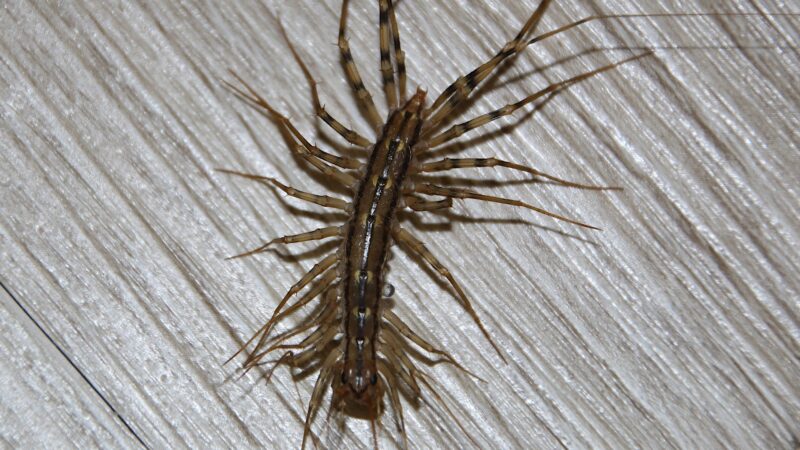
Common house centipedes are brown, black, or grayish-yellow with three longitudinal, dark stripes. They have compound eyes, three pairs of mouthparts, and well-developed antennae.
Their slender, flattened bodies are divided into 15 segments, with one pair of legs in each segment. Adult house centipedes are about 1 1/2 inches (38 mm) long.
The first pair of legs of house centipedes is modified into fangs, while the last pair of legs is almost twice the length of the body. Newly hatched larvae look like adults except that they are shorter and only have four pairs of legs until their first instar stage. As they molt and undergo two or three more instars, all of their fifteen legs will be completed.
The Lifespan of a House Centipede
House centipedes can live up to 7 years. They can be found hidden in dark, moist parts of your home.
Additionally, they are known to lay their eggs in moist soil in the spring and summer. When it’s warm outside, you start to see them as adults, which takes about 5 to 6 weeks during the winter months.
Where Do Centipedes Live?
They’ve undoubtedly been spotted before behind rocks in the yard and in your firewood pile. This is so because house centipedes like to reside in cool, moist conditions. They are frequently discovered beneath heaps of leaves as well.
They use a comparable strategy indoors. The basement or garage are good places to look. Additionally, they’ll squirm into restrooms.
How Do Common House Centipedes Get Inside Homes and Businesses?
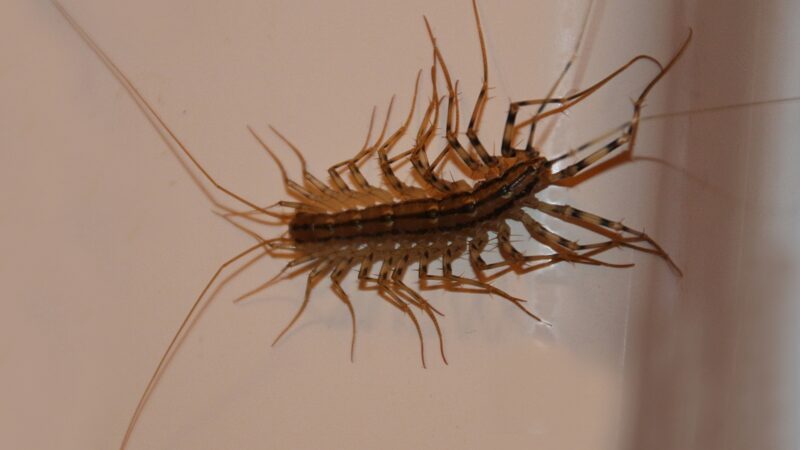
Aside from homes, house centipedes may also enter business establishments and buildings. They can enter by crawling through small gaps and cracks in walls, doors, or the foundation. These creepy arthropods can also pass through concrete slabs, unexcavated areas, uncapped blocks, and floor drains that have no water traps.
Common house centipedes are nocturnal creatures, which means that they hunt for food at night. During the day, they usually hide underneath rocks and logs.
Centipedes also tend to avoid humans. This is why you might not notice them as they enter your home or office. If you see them indoors, it may mean that there are a lot of insects inside.
Do Centipedes Crawl on You at Night?
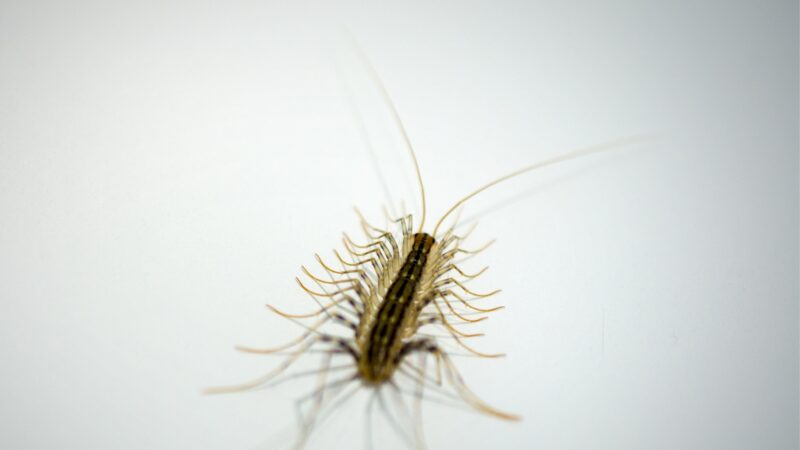
House centipedes can crawl on you at night. Since these night hunters prefer dark areas, they may accidentally climb onto your bed in search of food while you are sleeping.
These fast crawlers may remain in your bed for the entire night if there are lots of bed bugs. However, centipedes are likely to crawl away once you start moving.
Are Common House Centipedes Harmful to Humans?
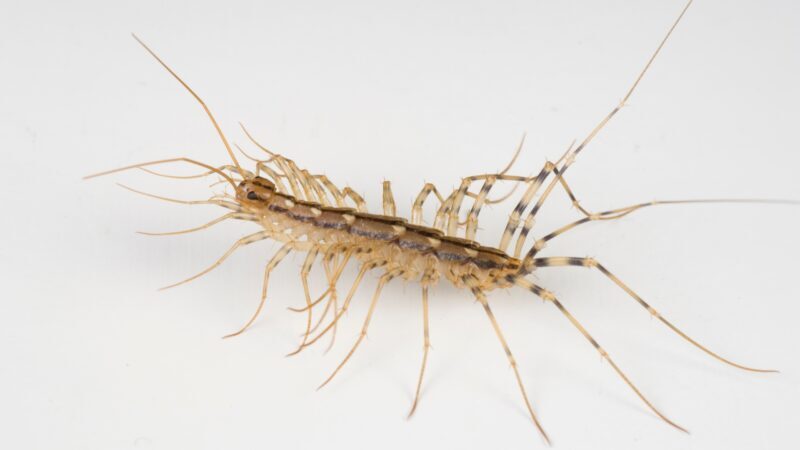
Common house centipedes are not considered harmful to humans and are not as aggressive as Amazonian giant centipedes. They may bite humans but very rarely and usually in self-defense only.
These active arthropods also don’t sting or carry infectious diseases. Centipedes, in general, are also not dangerous to pets such as cats and dogs.
Although they look scary, house centipedes are generally beneficial and help control insect pests. Despite having venom, their fangs are not strong enough to break human skin.
They are only designed for small household pests such as bed bugs, carpet beetle larvae, roaches, silverfish, and spiders. Centipedes don’t eat fabric, wood, and human food.
What Happens if a House Centipede Bites You?
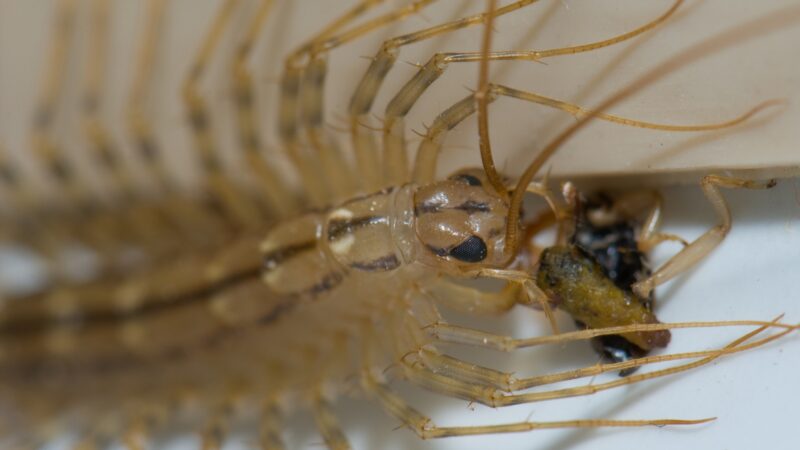
If a house centipede bites you, it is very unlikely to cause significant harm unless you have a severe allergic reaction to insect bites. Centipede bites are not neurotoxic to humans, which means that they are not toxic.
Technically, centipedes don’t have teeth, so they cannot bite. Instead, these crawlers use their fangs to inject venom into their prey.
If a centipede bite gets through your skin, the pain can be compared to a honeybee sting. Your skin might swell and have a small red mark, and you will also feel a mild burning or itching sensation.
In rare cases, it could lead to difficulty in breathing, hives, or swelling of the throat or face. But don’t worry; you will only need basic treatment.
What Attracts House Centipedes to Your House?
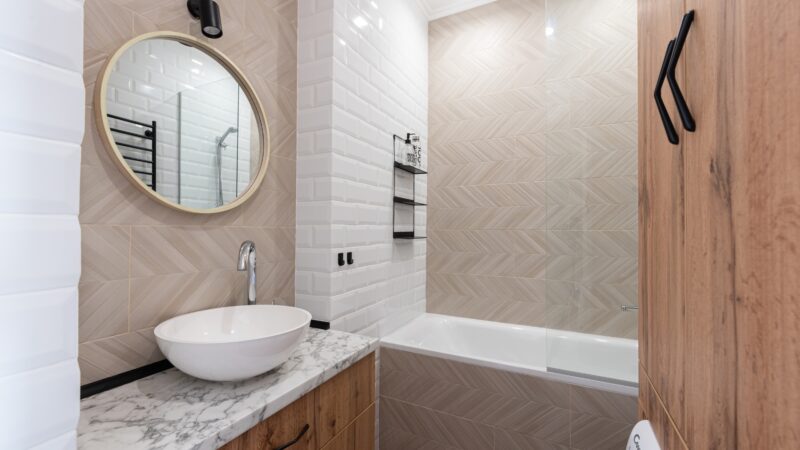
House centipedes are attracted to wet areas with high humidity levels inside your house, such as bathrooms and damp basements. They are also attracted to areas where there are insects or other small arthropods. These multi-legged creatures usually enter houses during spring and summer but rarely appear in winter and colder months.
How Can I Tell if I Have a Common House Centipede Problem?
Common house centipedes are huge enough to spot. But in some cases, you don’t have to see them to know that they are present.
Despite being harmless and non-destructive, centipedes can still cause some troubles inside your house. Below are some scenarios that will tell you that you likely have a house centipede in your house:
- House centipedes don’t come up through the drain pipes, but they can accidentally be trapped in drains. Therefore, it can result in clogged kitchen sink or bathroom and bathtub drains.
- You can also have house centipede problems if you have lots of crawling spiders and insects in hidden, dark areas such as closets and under shelves.
- If you notice a musty or damp smell in your house, it could be due to damp and humid areas that common house centipedes love to stay in.
- Your house may also have some water leaks in the kitchen or bathroom.
Should I Be Worried About House Centipedes?
You should not be worried about house centipedes since they don’t cause harm to human health or damage to properties. They may look scary but are not considered pests.
Their presence is a warning sign that your house is most likely infested with pests. So, if you see a house centipede, it’s probably time to inspect your house.
Is It Normal to Have Centipedes in Your House?
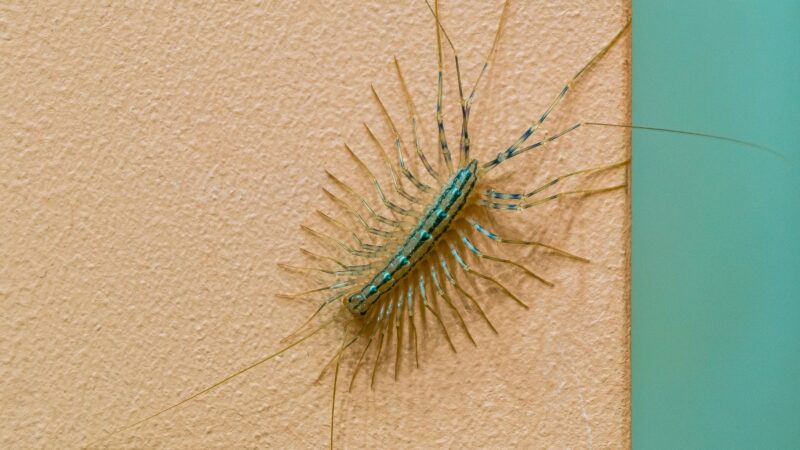
It is not normal to have centipedes in your house. Although these crawling creatures can live indoors, and some people keep them as pets, centipedes don’t belong to homes.
Instead, these uninvited guests should live outdoors in nature where they can freely forage for food. If there are centipedes in your home, you may have pest issues.
Should I Let Centipedes Live In My House?
You should not let centipedes live in your house unless you treat them as pets. Again, their natural habitat is nature and not indoors.
Although not dangerous, their bites can be painful. But if you can feed them regularly and make them live comfortably, it’s your choice to keep them. Yet, you should still investigate why they are in your home.
What Do I Do if There’s a Centipede in My House?
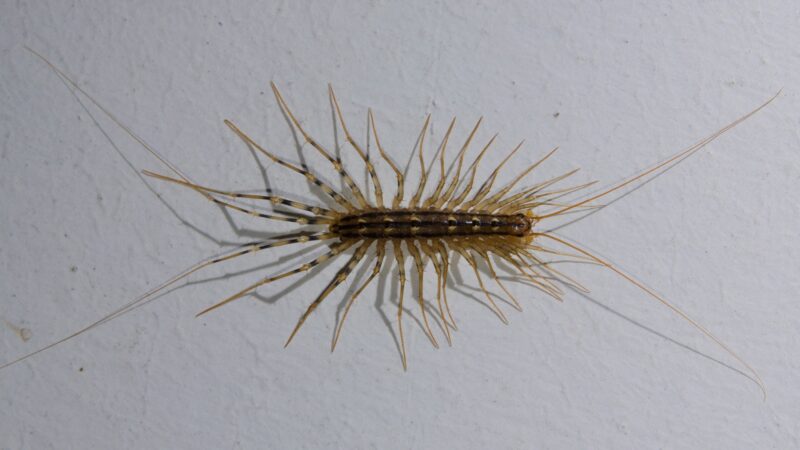
There are many things you can do if there is a centipede in your house. You can keep it as a pet as long as you can feed the animal. But if you are scared that you might get bitten, trap them.
If you are brave enough, you can gently pick them up one by one and relocate them. To avoid centipede bites, wear safety gloves and don’t use bare hands.
More importantly, inspect your house for possible pest infestation. Again, centipedes are carnivores, and they feed on spiders and pest insects, including cockroaches.
The presence of these so-called 100-legged night crawlers could also be a sign of water leaks. Aside from fixing broken pipes and faucets, keep your house clean and dry.
Should I Kill House Centipedes?
You should not kill centipedes even if you are tempted to. As mentioned earlier, these leggy creatures feed on insect pests and therefore are very beneficial.
Not to mention, they are not dangerous, and their bites are not venomous. But if you still feel uncomfortable having them in your home, trap them or call a pest control professional.
Why Should You Not Crush a Centipede?
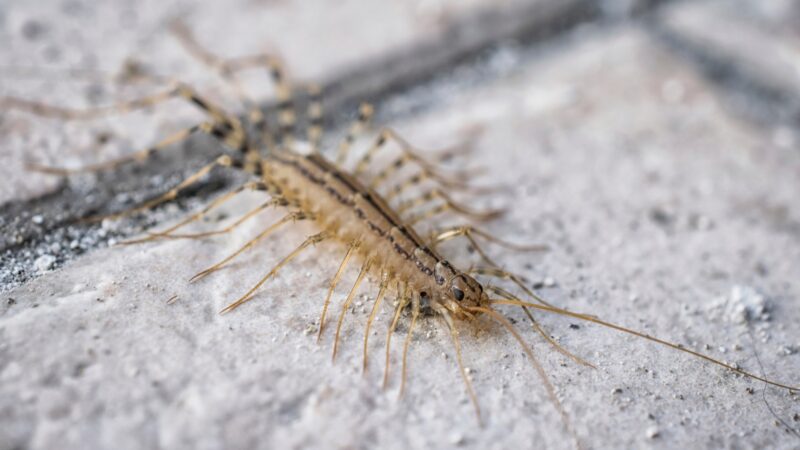
You should not crush a centipede to death because they are very beneficial creatures. Centipedes don’t pose health risks to humans and pets, and their bites are rare and not dangerous.
But more importantly, they are fierce predators of small household pests such as cockroaches and bed bugs. So, instead of crushing centipedes, relocate them.
Why Is Centipede Blood Purple?
Unlike humans, crustaceans, insects, and arthropods such as centipedes don’t have red blood cells. Instead, they have a fluid called hemolymph, which circulates through their bodies and performs functions like blood does in vertebrates. Although typically colorless, this fluid can appear blue or purple due to the presence of pigments called hemocyanin.
Hemocyanin is a copper-containing protein that turns purple (or blue) when oxygenated or when transporting oxygen throughout the bodies of invertebrates. It turns back to being colorless when deoxygenated. Human blood is red because it contains a protein called hemoglobin. On the other hand, peanut worms have purple blood due to hemerythrin.
Does Killing a Centipede Attract More?
Killing a centipede doesn’t attract more. Unlike ants, centipedes are not social creatures, and they don’t have a colony.
These creepy critters don’t care if one of their comrades dies, and a dead centipede will not emit a signal to others to come to that area. But again, centipedes are attracted to locations that have a lot of insects to prey upon.
How to Get Rid of Centipedes in Your Home?
If you want to get rid of house centipedes, use one or more of the following techniques:
- Eliminate their source of nourishment. Start by making every effort to get rid of any other household pests that house centipedes feed on. Spider, ant, and fly traps should be set up.
- A dehumidifier or a bathroom fan installation can help you by ensuring that there isn’t any extra moisture in your walls.
- To prevent pests from using your home as a nesting site, seal off any entry points.
- Clear your home of any debris that may be allowing unneeded moisture to seep into your walls.
Are There Traps for Centipedes?
There are traps you can use to catch centipedes. An easy DIY (Do-it-yourself) centipede trap is by getting a can or jar with an oily surface on the inside.
Place it around areas where these crawlers are. Once a centipede climbs and drops to the bottom of the jar, it can no longer escape. However, not all centipedes will be attracted to it.
For better results, you can buy inexpensive and ready-to-use Catchmaster centipede traps . Once a centipede steps on them, it will get stuck.
- READY TO USE: Centipede and Insect glue traps are intended for...
- YEAR-ROUND CONTROL: Catchmaster glue traps are pesticide-free and...
- HOME & FAMILY PROTECTION: Designed to help you keep your family...
- TOTAL COVERAGE: The indoor bug catcher can be used in...
- INTELLIGENT PEST MANAGEMENT: At our core, we are dedicated pest...
These glue traps have no chemicals or poison that can kill centipedes and are very sticky. Just make sure small children and pets cannot reach them. Trapped centipedes should be relocated safely.
How Can I Prevent Common House Centipede Infestations?
Despite being effective predators of common household pests, you might not want to have centipedes live inside your house. But once you remove these “helpful” guests from your home, they may come back anytime.
To help you out, here are some simple steps you can take to prevent a potential common house centipede infestation:
1. Seal Their Entry Points
Inspect your home for cracks and crevices in floors, walls, and ceilings. Then, seal any gaps that you find using weather stripping . This will not only help prevent centipedes from entering your house: but it will also help you control roaches and other insect pests.
- Foam Insulation Tape: The foam seal tape is made from Neoprene,...
- High Density Foam Tape: Air-tight sealing, sound proofing, heat...
- Closed Cell Foam Strip: Weather stripping features adjustability...
- Wide Range of Applications: The adhesive foam strips are widely...
- Strong Adhesive: Foam Weather Seal Strip is designed for both...
2. Eliminate Their Food Sources
Centipedes enter houses to find food, which includes cockroaches, silverfish, and spiders. Once you eliminate these pests, you are also removing their food source. Once centipedes enter your house, they are likely to leave soon to look for another place.
3. Reduce Humidity
Since centipedes thrive in areas with high humidity levels, you might want to control them. Installing exhaust fans in bathrooms and kitchens can help, as well as ensure proper ventilation in crawl spaces and basements. But for better results, use a dehumidifier .
- SMALL & COMPACT: Our lightweight and portable dehumidifier for...
- SAFE AUTO SHUT OFF: Our dehumidifiers for bedroom are ideal in...
- ULTRA QUIET & EFFICIENT: Get the best of your dehumidifier for...
- EFFICIENTLY LOWERS HUMIDITY: Perfect dehumidifier for high...
- AWARD WINNING BRAND: Pro Breeze is a world leader in small...
4. Keep Your House Clean Tidy, and Dry
To remove potential food sources of house centipedes, clean your house regularly. Remove clutter and vacuum every corner at least once a week. To reduce moisture, empty the refrigerator drip pan regularly. Fix broken faucets, pipes, and clogged drains.
Related: How to Get Rid of House Centipedes Naturally? | Control Guide
List of Sources
Jacobs, S. (2017). House Centipedes. PennState Extension.
Fox, R. (2006). House Centipede. Lander University.
House Centipede. Iowa State University.
- How to Get Rid of Copperheads | Practical Guide - August 27, 2023
- How to Get Rid of Corn Snakes | What Makes Them Aggressive? - August 27, 2023
- How to Get Rid of Alligators | Safety Measures and Removal Methods - July 16, 2023



